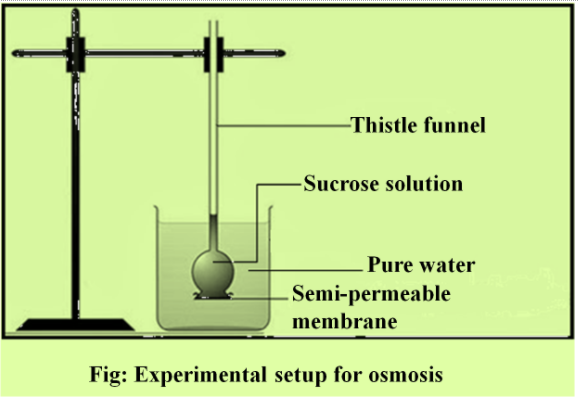
Which of the following experiments is called a physiological demonstration of osmosis?
(a) Thistle funnel- whose mouth is tied with egg membrane
(b) Thistle funnel- whose mouth is tied with parchment paper
(c) Both (a) and (b)
(d) Bell jar experiment
Answer
580.2k+ views
Hint: Osmosis refers to the diffusion of water across a differentially permeable or semipermeable membrane. A semipermeable membrane selectively allows the movement of a solvent while restricting the movement of solutes.
Complete answer:
The physiological demonstration of osmosis involves a semipermeable membrane tied to the mouth of thistle funnel, which is filled with sucrose solution. This semi-permeable membrane can be natural or artificial. The egg cell membrane is a natural semipermeable membrane while parchment paper is an artificial semipermeable membrane.
Additional Information:
This physiological demonstration of osmosis involves filling of a thistle funnel with sucrose solution and kept inverted in a beaker containing water. A semipermeable membrane acts as a barrier between the sucrose solution and pure water.
As osmosis involves the passive movement of water from a region of its high concentration to a region of its lower concentration, water will move into the funnel as pure water has the highest concentration of water and addition of any solute only decreases its concentration. This continuous movement of water from beaker into the funnel will result in a rise in the level of sucrose solution. This will continue until the equilibrium is reached.
Bell jar experiment proves that for any sound to propagate, it requires a material as its medium.

So, the correct answer is ‘both a and b.’
Note: Membranes can be impermeable, permeable, semi permeable or selectively permeable.
― Impermeable membranes don’t permit the entry of any solvent or solute. E.g. Lignified cell wall.
― Permeable membranes like a cellulosic cell wall allow all solute and solvents to pass through them.
― Selectively permeable membranes like plasma membrane and tonoplast allow only certain substances to pass through while preventing others.
Complete answer:
The physiological demonstration of osmosis involves a semipermeable membrane tied to the mouth of thistle funnel, which is filled with sucrose solution. This semi-permeable membrane can be natural or artificial. The egg cell membrane is a natural semipermeable membrane while parchment paper is an artificial semipermeable membrane.
Additional Information:
This physiological demonstration of osmosis involves filling of a thistle funnel with sucrose solution and kept inverted in a beaker containing water. A semipermeable membrane acts as a barrier between the sucrose solution and pure water.
As osmosis involves the passive movement of water from a region of its high concentration to a region of its lower concentration, water will move into the funnel as pure water has the highest concentration of water and addition of any solute only decreases its concentration. This continuous movement of water from beaker into the funnel will result in a rise in the level of sucrose solution. This will continue until the equilibrium is reached.
Bell jar experiment proves that for any sound to propagate, it requires a material as its medium.

So, the correct answer is ‘both a and b.’
Note: Membranes can be impermeable, permeable, semi permeable or selectively permeable.
― Impermeable membranes don’t permit the entry of any solvent or solute. E.g. Lignified cell wall.
― Permeable membranes like a cellulosic cell wall allow all solute and solvents to pass through them.
― Selectively permeable membranes like plasma membrane and tonoplast allow only certain substances to pass through while preventing others.
Recently Updated Pages
Master Class 11 Economics: Engaging Questions & Answers for Success

Master Class 11 English: Engaging Questions & Answers for Success

Master Class 11 Social Science: Engaging Questions & Answers for Success

Master Class 11 Biology: Engaging Questions & Answers for Success

Class 11 Question and Answer - Your Ultimate Solutions Guide

Master Class 11 Business Studies: Engaging Questions & Answers for Success

Trending doubts
What is meant by exothermic and endothermic reactions class 11 chemistry CBSE

10 examples of friction in our daily life

One Metric ton is equal to kg A 10000 B 1000 C 100 class 11 physics CBSE

Difference Between Prokaryotic Cells and Eukaryotic Cells

What are Quantum numbers Explain the quantum number class 11 chemistry CBSE

1 Quintal is equal to a 110 kg b 10 kg c 100kg d 1000 class 11 physics CBSE




